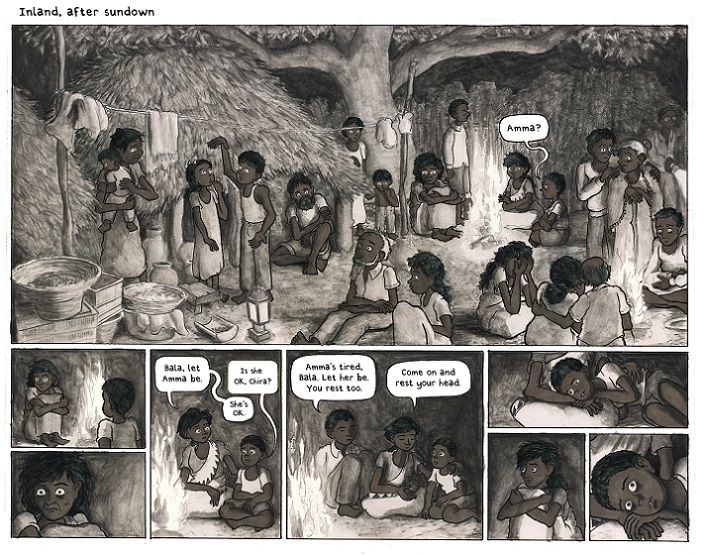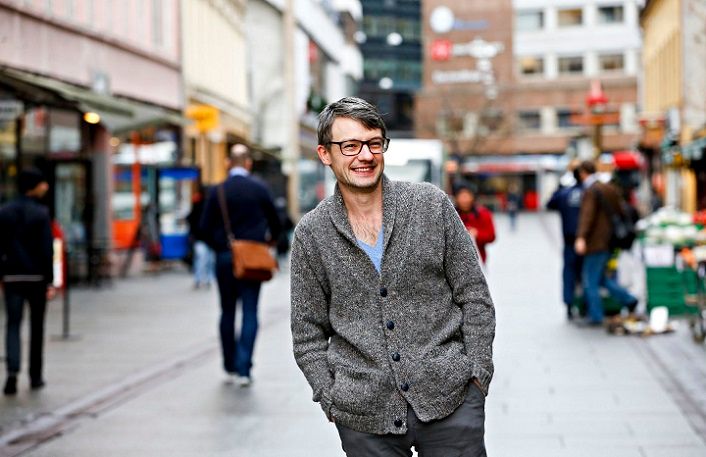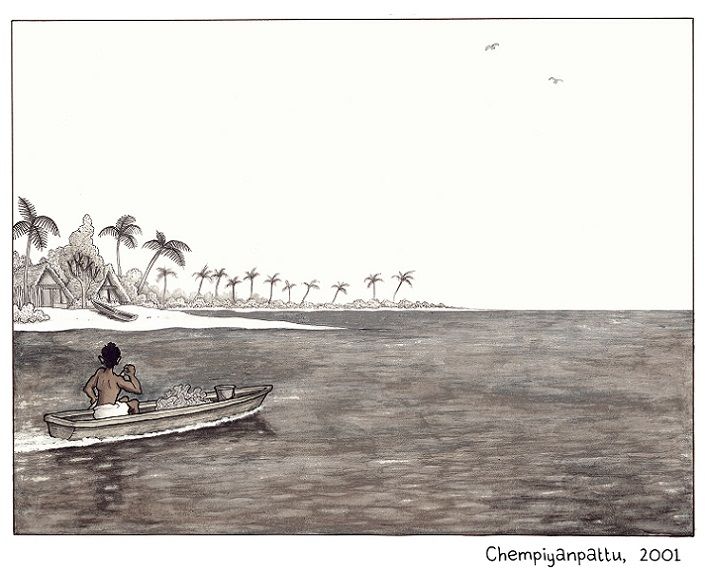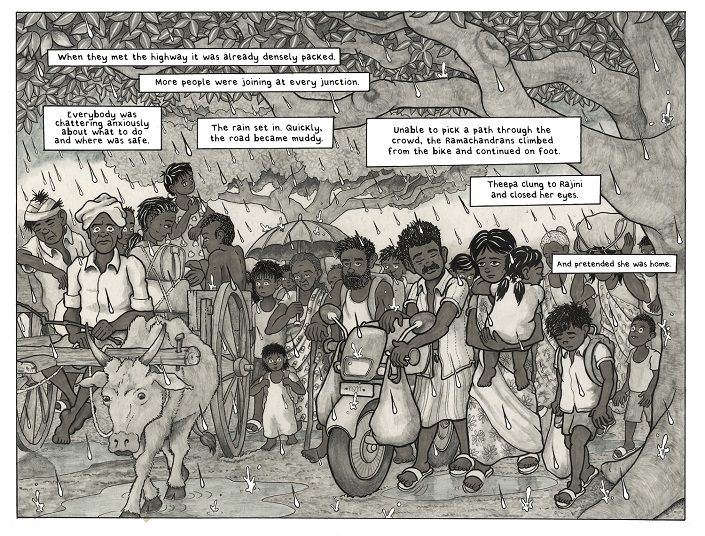First Comics News: Why did you feel the need to write “Vanni”?
Benjamin Dix: I wanted to tell the human story of what people had suffered in Vanni. People that I knew as friends and my colleagues – the ones that survived and to record the memories of ones that had died. I tried writing these accounts academically but it didn’t have the impact I was looking for. Inspired by Maus and Palestine that I read in the bunker whilst in Vanni, I decided I would try and write it as a comic book. I thought it would be a 20-30 page comic, telling a single story, but then the project grew into what it is today. I also wanted the project to be an emotional ‘closure’ for me. I wanted to record a moment in history that was largely unreported in the world media – it was Sri Lanka, not Syria and I felt that the Sri Lankan people who suffered should have their story recorded for the world to understand what modern day conflict looks like and why many people are refugees in the world and what they have escaped from.
1st: Can you give us a brief outline of the story in “Vanni”?
Benjamin: • We start with the everyday life before the tsunami in 2004.
• Setting the scene of an average fishing family on the NE Sri Lanka in a place called Vanni
• Vanni is controlled by the rebel group, Tamil Tigers
• Every family has a member that is part of the Tamil Tigers and are generally revered by the community.
• The tsunami is a catastrophe that upsets the community and people are displaced to live in camps after the homes are destroyed.
• The war then starts between the government and the Tigers and again the community are displaced into internment camps.
• Food and material items become scarce and the community has to grapple together
• Civilians are conscripted into the Tiger ranks that further upsets the sensitive balance of the community
• The war rages on and the civilians are trapped on the beach in the notorious ‘No Fire Zones’ where they are subjected to intense violence by the Sri Lankan army and held captive by the Tigers
• At the close of the war, many Tigers are executed and women are raped by the army
• Many survivors are captured by the army and tortured
• People flee the Sri Lanka and become refugees in Europe and North America
• Myself and Lindsay interviewed refugees in London, Zurich and Chennai to gather their stories and amalgamate them into fictionalised characters that play out the testimonies we recorded.
1st: Are the characters in “Vanni” based at all on real people?

Benjamin: • I interviewed hundreds of people whilst I worked in Vanni for 4 years (2004-2008) concerning the tsunami and then the war and displacement.
• Lindsay and I then interviewed around 20 Tamil refugees in London, Zurich and Chennai
• Due to security concerns of people’s identity we decided that we would amalgamate these interviews into a fictionalised family that you see in the book.
1st: What or who are the Tamils?
Benjamin: Tamils are an ethnic group mostly based in North Sri Lanka. They are mostly Hindu (inland) and Christian (fishing community on the coast). They comprise of around 20% of the population of Sri Lanka and are the largest minority.
1st: Why is Black July something to be remembered?
Benjamin: It was a disastrous riot across the country and capital, Colombo, where the Sinhalese community attacked Tamil homes, businesses and individuals. It was in retaliation to the Tigers killing 13 Sinhalese soldiers in the north of the country. The police allowed it to happen and the Sinhalese had electoral lists so they knew where the Tamils lived and worked. The death toll has never been verified but it was between 1000-3000 dead and it injected a new energy into the Tamils in the north joining the ranks of the Tigers to fight back.
1st: How would you describe the effect war has on children?
Benjamin: Like any war – it injects fear into children and hardens them. They witness death on a massive scale and the psychological effects are profound. There is a lack of food and material items that are needed for healthy growth of children. There is the lack of parental focus as the parents are trying to survive rather than nurture their children. There is a lack of ‘play’ between children.

1st: How does Lindsay Pollock’s art do justice to the situation in this book?
Lindsay: At the time the project was conceived, it was not possible for Ben to enter Sri Lanka (following his public criticisms of the government’s actions). For me to get a sense of the culture, landscape and lifestyles of the Sri Lankan Tamils – especially before the tsunami – we visited southern India, traveling by motorbike through Tamil Nadu.
I was able to photograph, sketch and record details first hand – from the fishing villages, to the markets, to the skinny stray dogs, to the bikes, the huts with walls woven from palm leaves – the plains, the jungles and the paddy-fields, the cows, the simple brick churches, the cement wells… and countless other features of ordinary life.
Back in London, I supplemented those sketches with Ben’s own photographs (taken in Vanni as the war escalated), and from the archive of harrowing images available online – notably at the website TamilNet. That site collated in-depth records about the war, and gradually became a repository of horrifying photos from people’s digital cameras – firsthand evidence of atrocities.
The Channel 4 documentary ‘No Fire Zone’ [Callum Macrae], in which Ben appeared, was another source of imagery for locations and characters. I watched that documentary carefully, particularly for the ways in which people behaved in extraordinary circumstances. Like, in the terror of a shelling attack, or in the traumatised aftermath.
Francois Truffaut said there’s no such thing as an anti-war film. Essentially because of the nature of watching combat on a screen: from the safe, detached and passive position of the viewer, the spectacle of the fighting is unavoidably exciting and glamorous, whatever moral and emotional horror is intended.
So I was worried about inadvertently doing that. I took an approach of depicting the fighting in a banal way. And I focused a lot on the consequences rather than the action. There’s a scene in the book which takes place on a notorious night of terrifying shelling in the No Fire Zone. There’s a temptation to draw that in a spectacular – but I kept the scene very short, and focused on the family’s terror. The scene following – which shows the aftermath the following day – covers the next ten pages of the book.
I tried to have the characters respond naturally, copying what I had seen in the documentary and photographs. I depict people as scared, despondent, shocked and wordless. I tried to use the arrangements of panels and the composition of images to reflect psychological experiences. There’s another scene where the family are having their hair cut, but it’s interrupted by a shell dropping on the hospital.
Antoni helps to clear the rubble of bodies and bury them in a shared grave. His placement in that image is repeated exactly on the next page, when he’s back with his family and staring into the fire. I wanted to suggest he was stuck – mentally – in that moment of horror.
So there’s a number of things – visual / literary devices – which can deployed in a comic to bring an experience to life. And I tried to use those devices, to convey the way the war had been described to us, in as dry and truthful a way as I could.

1st: Why is a comic book a good way to deliver this story of “Vanni”?
Benjamin: Comics reach a different readership than journalism. And they connect with people in a different way.
The initial impulse for the book was publicity – to alert the general public to the injustice which had befallen the Tamils. It was intended to educate and campaign but the project changed and grew over time.
We hope activists and teachers will find the book useful – but even when its topicality recedes into the past, the book should remain valuable as an unvarnished account of war. It’s intended to indict powerful states who indulge in disproportionate and depraved violence against civilians in response to social and political disputes.
It’s also a testament to the non-violent heroism of ordinary people who strive to sustain one another in the face of terror and atrocities.
We decided early that we would write a fictionalised account. That was for various reasons – principally, to protect the anonymity of the people who shared their experiences with us. Many were in vulnerable circumstances as asylum seekers, or still having loved ones and relatives in Sri Lanka who could fall victim to retaliation from the authorities.
The war affected so many people. We were drawing from a great many sources. so we synthesized a number of different testimonies into a set of stories and characters which touched on all the important issues we wanted to depict. But which itself remains entirely plausible; many Tamils will have lived experiences almost exactly like those depicted. Many will have experienced – and continue to experience – worse circumstances.
1st: Why do you tackle tragedies and not some other genre?
Benjamin: • I’ve worked in the humanitarian sector for nearly 20 years so I’ve seen a lot of suffering and strength of people within that suffering.
• Therefore my contacts and networks are very much in ‘that world’ of humanitarian and human rights.
• I wrote my PhD in Anthropology on conflict and violence and the transformation of complex and traumatic testimonies and how to turn that into sequential art. The Vanni book was the foundation of my thesis.
• PositiveNegatives was developed from Vanni and again my networks are in the academic and humanitarian world dealing with human rights, migration, conflict, violence etc.
• So PositiveNegatives tells these stories.
• The medium of comics and animations is perfect for these stories as it anonymises people who are vulnerable and for many reasons, don’t want to show their identity so they can hide behind the illustrations.
• Also comics and animations allows us to tell parts of the stories where you cannot film or photograph – like detention camps, human traffickers, inside conflicts etc – when we interview survivors of these issues, they can describe to the artist what it looked like and we can draw the issues. So it takes the reader into spaces where other mediums find it hard to reach.
1st: What are you working on now or will you be working on next?
Benjamin: At PositiveNegatives we’re currently working on 15 projects across 34 countries! We’re working on mostly academic research projects where our methodology of adapting testimonies to artwork are now embedded into academic research. Below are a few of the projects:
• Drawing on Rights
• Drugs and Disorder
• South to South Migration
And we’re developing our educational resources of taking all our portfolio into schools and working with teachers to educate students on these complex issues. It’s called PositiveNegatives Learning.

1st: What is PositiveNegatives purpose?
Benjamin: Can see on our website
1st: Have you had any life defining moments in your life?
Benjamin: Many!
• Living through the Sri Lankan conflict
• Evacuating from the conflict
• Motorbiking all over the world.
• Falling in love with my wife-to-be – I’m getting married in 2 weeks on 14th September – 5 days before Vanni is launched!
• Travelling and working in 80’ish countries
1st: How do you take your mind off the tragedies you write about?
Benjamin: I motorbike. This summer I rode over the 3 highest roads in the world in the Himalaya along the Pakistan and Tibetan borders.
1st: What would you like to say to those who have suffered a tragedy you have written about?
Benjamin: Thank you for trusting me with your stories and I hope we at PositiveNegatives have done them justice and told them with dignity.

